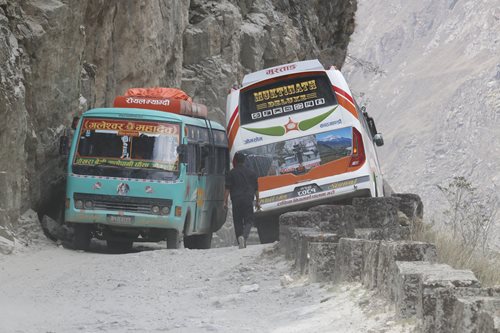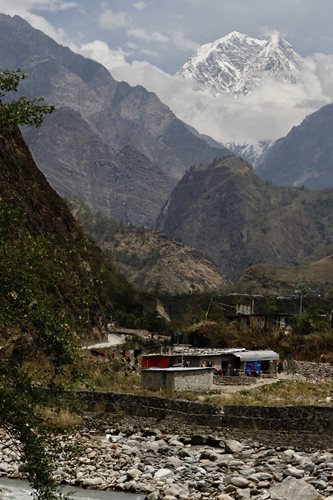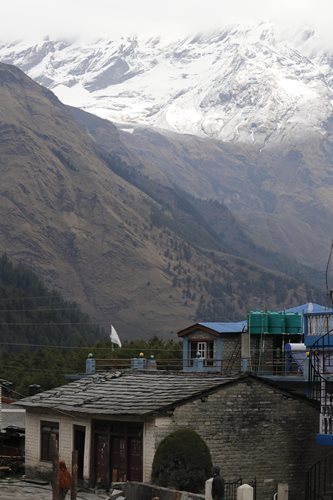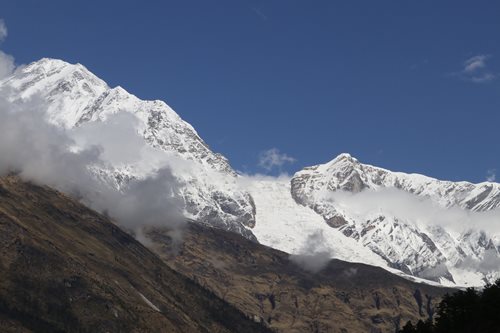The rest of Day 4 was tough. In many of the places where the road climbed steeply it wasn’t a road at all but effectively a slot in the mountainside where the surface we rode over was an arrangement of medium to large boulders (the smallest were a foot / 30cm across) as if someone had tried to achieve a giant cobblestone effect then there has been an earthquake. Sometimes there were slippery bands of limestone sticking up at an angle of 45° or washing-up-liquid-slippery silt. With my exceedingly poor head for heights I convinced myself that there was a real risk of sliding off the road and into the river that was now a very long way below the road. It wasn’t enough to concentrate on the ‘road’ surface either as there were always surprises. There was the occasional rockfall (albeit small scale ones) or suicidal chickens and at one point my progress was arrested by a squadron of kamikaze goats that jumped onto the road from the scrub and rough grazing above. And birds and butterflies would catch my attention but I dared no more than a glance at them.
The countryside was looking drier and the houses made of stone, box-shaped and flat-roofed, in the Tibetan style. Soon it felt like we had left the sub-tropics and I realised we were in lower Mustang and climbing up onto the Tibetan Plateau. We rode through lovely scented pine forest and the way wound up and ever up. Clouds rolled in and I wondered how challenging it would be to drive this in pouring rain. The drop into the river from the road was ever more vertiginous and on the other side of the precipitous valley there was a great white gash nearly a kilometre long and more than 300m high – evidence of a catastrophic landslide.
When we reached Kalopani at around 4pm, we’d ridden a mere 26km but had ascended 1300m. The air felt cold but the steamy shower (heated by solar power) at the Four Peaks Hotel felt unbelievably luxurious. And it was good to get our various scrapes and grazed cleaned up and redressed. Alex’s looked like they were getting infected.
Feeling refreshed, we wandered out to take in the sights of Kalopani. They were few. That didn’t matter though as we were suddenly so close to snow that almost looked like we could land a snowball on the nearest peaks. And the pine forest on the lower slopes was of the deepest green. We watched huge birds of prey wheeling and playing on updrafts.
I’d gone out with wet hair and began to feel seriously cold, despite wearing a sweatshirt and fleece and wondered if I could be sickening for something. I couldn’t stop shivering as we waited for our dal bhat. Our hotel boasted an internet connection (although only in the evening) so we capitalised on that to check the weather. Snow was forecast in Jomsom – our next target. It also explained my shivering. We were over 2500m above sea level and the air temperature was no more than -2°C.
Alex was in touch with a friend who had just done this same journey on a small bike and had emphasised how road conditions had been especially challenging in Mustang and deteriorated the closer he got to Muktinath.
We were both quite sore. I’d dropped my bike six times thusfar and Alex’s grazes were looking infected. This was the point we almost certainly decided that discretion might be the better part of valour. We’d be seriously stuffed if it snowed.
Over delicious rice, lentils, local yoghurt and curry, our hostess talked of how people often were trapped with her for days.
‘The roads are rotten,’ she said, as if we hadn’t noticed.
 |
| In concept of Passing Places is a little different in the Himalayas |
 |
| Riding north from Beni took us from the sub-tropics towards the eternal snows |
 |
| Winding up into pine forest |
 |
| Buffalo calf at Kalopani |
 |
| Kalopani at about 2500m where the weather is unpredictable and changes rapidly |
 |
| The skies started to clear but snow threatened |
This is part six of seven posts on our Mum-and-Son transHimalayan trip. The first is here
transHimalayan Adventure. The next is
Jam and pakoras.